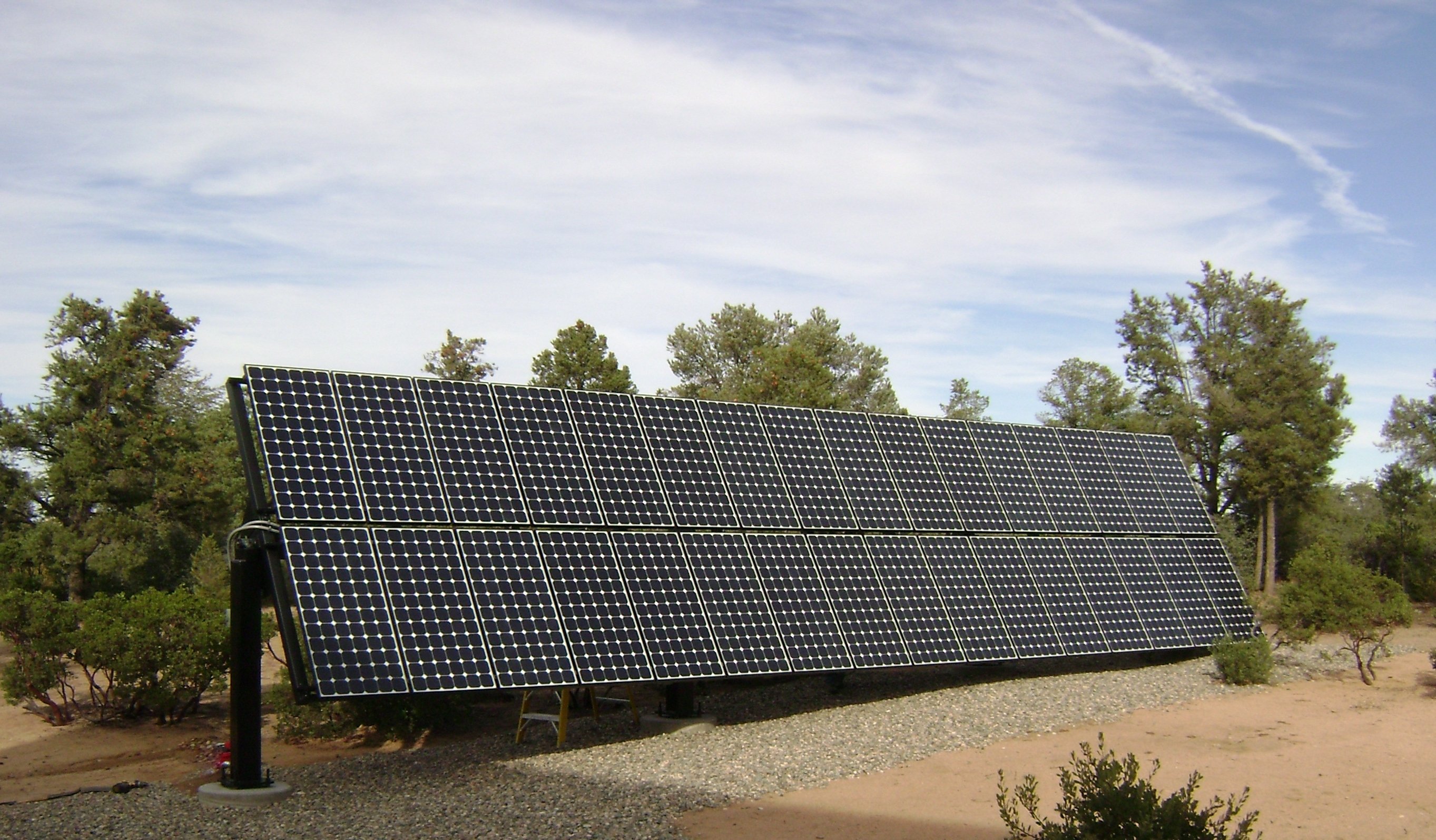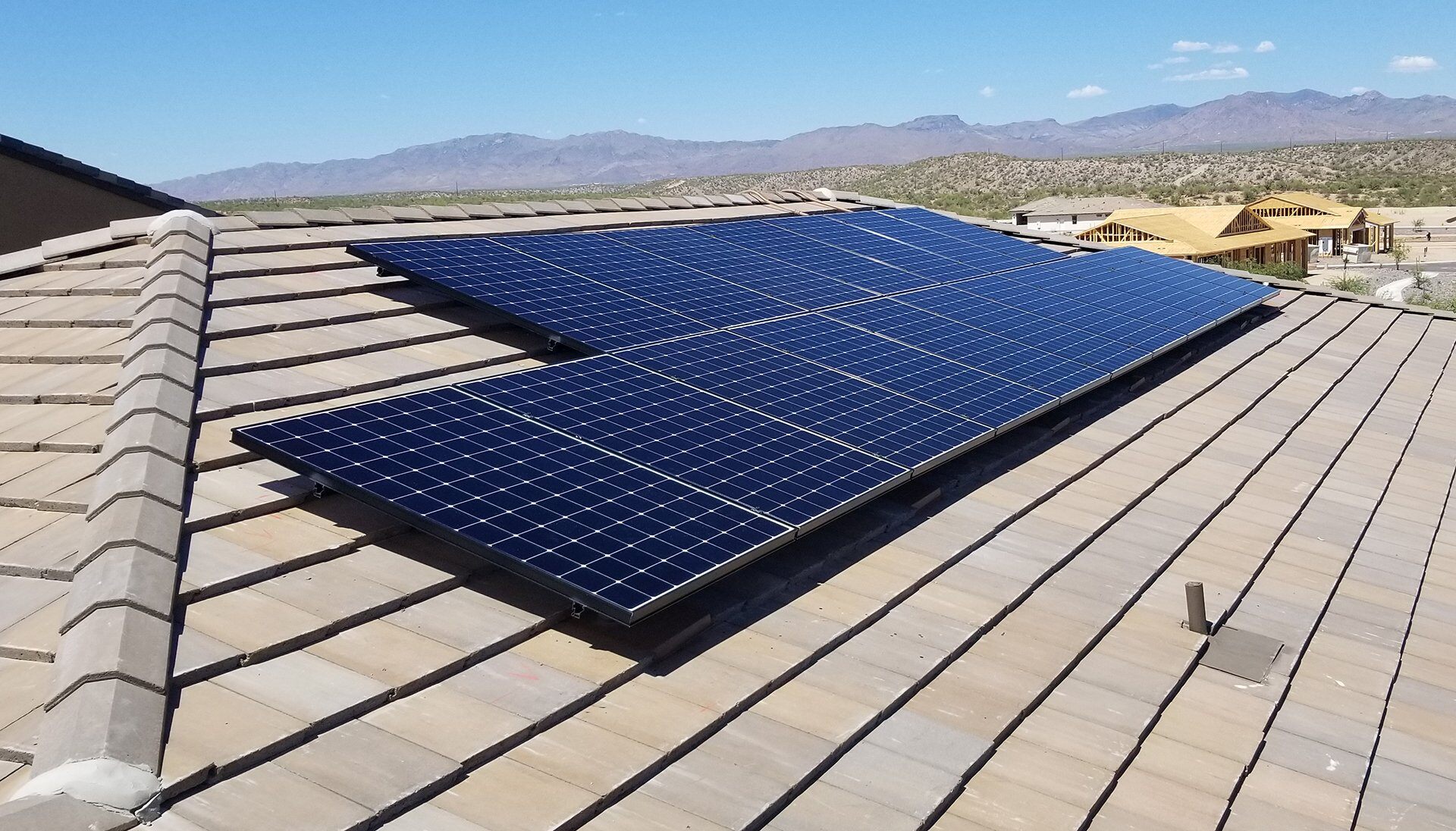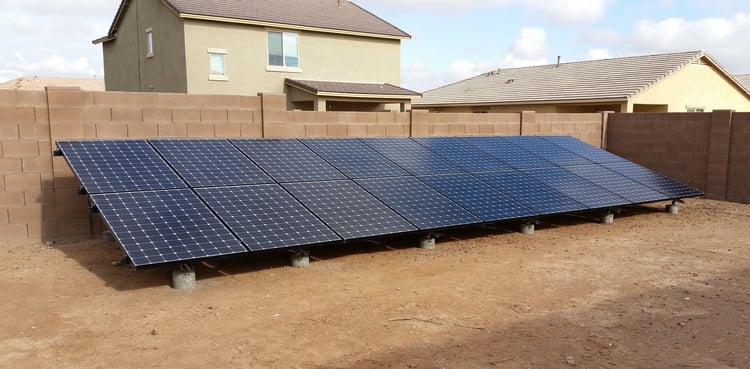Most homeowners are aware of rooftop solar panels, but ground-mounted systems are another option for those who have limited roof space or otherwise want to avoid attaching solar panels to their rooftop. As the name implies, ground mount arrays are built into the ground and secured with a concrete foundation.
If you’re exploring solar power and want to know your options, keep reading to learn the differences between ground-mounted and rooftop solar systems. Each of these options has their own unique benefits and drawbacks and are suitable for different property types and energy needs.
What are ground-mounted solar panels?
Ground-mounted, or ground mount, solar panels are installed directly into the ground using a secure racking system. They’re an excellent option for properties with plenty of space and sun exposure, or if a property owner simply doesn’t like the aesthetics of a rooftop array.
There are two main types of ground-mounted systems: fixed-tilt and tracking mounts:
- Fixed systems are tilted to capture the most sunlight based on a fixed location.
- Tracking systems follow the sun’s path across the sky and adjust their angle throughout the day for optimal energy capture.
Ground-mounted solar panels can be installed anywhere with strong sun exposure, provided there's enough space for the required number of panels and the soil can support the racking system. The structure typically consists of metal racking mounted on vertical poles secured in concrete. A trench is then dug to run electrical wiring between the ground array and your home.
Learn more about ground-mounted solar in our blog article: Ground-Mounted Solar Panels - Get the Essential Info You Need.
Pros and cons of ground mount solar panels
Ground-mounted solar panel systems can be a great option for homeowners with extra space and specific energy goals, but they also have certain drawbacks. We look at the pros and cons of ground mount solar below.
Pros of ground-mounted solar
More flexibility in placement (+ more energy production)
Ground-mounted systems don’t rely on your roof, so they are less limited by space and can be oriented perfectly for maximum sunlight capture. This helps maximize solar energy production so you get the most cost savings out of your investment.
Easier access for maintenance
Being lower to the ground makes it easier to clean your solar panels, troubleshoot performance issues, and perform occasional maintenance without needing roof access.
Read More: Solar Performance Monitoring - Best Practices
Cooler temperatures
Solar panels installed on the ground have more airflow beneath them, which means they tend to run cooler compared to their rooftop counterparts. Because solar panels can slightly lose efficiency when they’re too hot, this can be an added benefit.
Learn more about how solar panels work in extreme heat in our blog: How Extreme Heat Affects Your Solar Energy Production.
No roof penetrations required
Ground-mounted systems avoid the need for roof penetrations—often dozens in a typical rooftop install. While a properly installed rooftop system using the industry-standard 3-course sealing method (which we follow as part of our Platinum Installation Methodology) should never leak, not all installers follow these best practices.
Click here to watch a video detailing our 3-Course Plus sealing process:
Support tracking systems
Ground-mounted solar panels can use trackers to follow the sun and boost energy production. However, in most residential settings, the added output typically doesn’t justify the extra cost. That said, every site is different, and a proper evaluation can determine if a tracker makes sense.
Accommodate more solar panels
Because ground-mounted systems don’t rely on your roof, you can install as many solar panels as you need, regardless of the size of your roof. This can be ideal for meeting high energy needs with off-grid setups or expanding in the future.

Cons of ground mount solar
Higher upfront costs
Ground-mounted systems are more expensive than rooftop systems as they require more materials and labor. Other factors like trenching, structural foundations, permitting and landscaping drive costs even higher. Often a ground mount will double the total system cost.
Takes up yard space
Typical residential ground mounts will require a large, unobstructed area (sometimes a quarter to half an acre or more). If you have a smaller property or want to preserve your yard space, they may not be a suitable option.
More complex permitting process
Some local governments consider ground-mounted solar systems to be a ‘new construction’ or standalone structure. For that reason, they often require additional permitting and site evaluations (including setback measurements from property lines, load-bearing calculations, environmental impact studies, and highly detailed structural drawings). This can slow down the approval process and make installation more complicated, although a trusted installer can guide you through the process.
More exposed to the environment
Being at ground level means ground mount systems are more vulnerable to flooding, dust, debris, and potential interference from animals or people, which can lead to wear and tear faster compared to rooftop systems.
Keep Reading: Solar Panel Pigeon Proofing: Ensure Long-Term Performance
Considered less aesthetically pleasing
Some people consider ground mount panels to be less visually appealing since they take up space in the backyard and are typically more visible than rooftop arrays. They also interfere with landscape design.
What is a roof-mounted solar system?
Roof-mounted solar systems are the most common type of residential solar installation. They involve attaching solar panels directly to the roof of your home using a racking system.
You can install rooftop solar on a range of roof types, including flat, pitched, tile, or metal roofs. It’s often the most cost-effective and convenient option for installing residential solar panels (which is why it’s the most common).
Pros and cons of roof mount solar panels
Like ground-mounted systems, rooftop solar systems come with certain benefits and drawbacks. We look at the pros and cons of rooftop solar below.
Pros of rooftop solar
More cost-effective
Rooftop systems are considerably less expensive to install compared to ground mount systems. Since your roof already exists, there’s no need to build a separate structure or trench for wiring, which keeps material and labor costs down compared to ground mount systems.
Don’t take up space
One of the greatest advantages of rooftop vs ground mount systems is that they make use of space that would otherwise go unused. This makes them more suitable than ground-mounted panels for properties with limited space or homeowners who want to preserve their landscape design.
More simple permitting process
The permitting process for rooftop solar is faster and more straightforward compared to ground-mounted systems.
Added protection for your roof
Having solar panels on your roof can provide an extra layer of defense against Arizona’s intense sun, wind, and rain. They can also insulate your home by shading the roof surface, potentially helping you save even more on energy costs.

Cons of rooftop solar
Limited space for installation
The size of a rooftop solar system is generally restricted to the roof space you have available, which can be limited by vents, chimneys, and shading. That said, most residential roofs can accommodate a good-sized solar system.
Read More: Calculate the Number of Solar Panels You Need
More difficult access for maintenance
It can be harder to access rooftop solar panels for cleaning or maintenance, especially if you live in a multi-level home.
Limited tilt adjustment
Unlike ground-mounted systems, rooftop solar panels are usually fixed to match the angle and orientation of your roof. If your roof doesn’t get a lot of sun exposure, it might mean you’ll need a couple of extra panels to reach your desired output.
Learn More: Solar Panel Direction: What is the Best Angle?
When is ground-mounted solar a good option?
Rooftop solar is the most popular choice for homeowners, thanks to its affordability, fastest return on investment, quick installation timeline, and minimal impact on property or landscaping. However, in some cases, a ground-mounted system may be the better option. You may want to consider ground-mounted solar if:
You’re living off-grid or in a remote area
Ground-mounted solar often makes sense for off-grid homes and remote properties. In these situations, rooftops might not offer the surface area you need to generate enough electricity, especially if your home is relying exclusively on solar to power everything.
With a ground-mounted system, you’d be able to build out a larger array and scale it as needed (depending on the size of your property). This kind of flexibility is often essential for off-grid setups where you need reliable and consistent energy production.
You don’t have enough roof space
Maybe you already have rooftop solar and want to expand your system but don’t have enough space (or your roof is shaded or irregularly-shaped). In these cases, ground-mounted panels can help you expand your solar system without needing more roof space.
Some reasons why people choose to expand their solar system in the future are to charge EVs, add workshops or home offices, or simply offset more of their utility bill.
Your roof isn’t suitable for solar
While most roofs are capable of supporting solar panels, not all of them are a good fit. Ground-mounted solar arrays can offer an alternative if:
- Your roof isn’t structurally sound: Older homes or those with existing damage may not be able to support the weight of a full solar system. In these situations, a roof replacement is recommended before installing solar, but another option is to install ground mounted panels.
- Your roof is north-facing: In the Northern Hemisphere—where Arizona is located—south-facing panels receive the most sunlight. If your roof faces north, solar is still possible, but a ground-mounted system offers the freedom to choose the ideal orientation for higher production, making it a smarter financial choice in some cases.
- Your roof is too shaded: If your roof is shaded by nearby trees or buildings, a ground-mounted system can be positioned in a sunnier, unobstructed area to maximize solar production.

When is rooftop solar a good option?
Rooftop solar tends to be the most practical and cost-effective solution for that vast majority of Arizona homeowners, especially those living in suburban areas. Some situations where roof-mounted solar makes sense include:
You want to maximize ROI with a lower upfront cost
Rooftop systems use an existing structure – your roof – so there’s no need to build a new foundation or run long electrical trenches. This translates to lower installation costs and a faster return on investment, making rooftop solar the shortest path to saving money with solar.
See: Solar Panels ROI: Calculating Your Average Returns
You don’t have much yard space
Backyard space is often limited in residential neighborhoods. Rooftop solar makes use of space that would otherwise go unused, leaving your yard free to be used for gardening, play areas, outdoor entertaining, and anything else you like.
You want a simpler permitting process
As mentioned earlier, it’s usually faster and more straightforward to obtain permitting for rooftop solar compared to ground mounts. This means you’ll likely get your system up and running sooner.
Your roof has good sun exposure
If your roof has enough space and gets a good amount of sun throughout the day, it’s a great candidate for solar. Even if your roof isn’t perfectly south-facing, today’s high-efficiency solar panels can deliver great results on most roof orientations.
Summary: Ground mount vs roof mount solar
No solution is better than the other – both ground-mounted and roof-mounted solar systems are great ways to harness Arizona’s abundant sunshine and generate renewable energy. Choosing between the two often comes down to your property layout, budget, energy goals, and aesthetic preferences.
Here’s a quick summary of the differences between ground mount and roof mount solar:
Cost
Roof-mounted systems are generally more affordable because they use your existing roof for support. Ground-mounted systems require building a separate structure, which adds costs for materials, labor, trenching, and permitting—making them more complex and expensive to install.
Permitting
Permitting requirements can vary depending on your location and the type of system, but ground mounts often require additional plans or documentation. In some cases, they might be restricted in visible areas. Rooftop solar, on the other hand, has a faster and simpler approval process.
Production
Ground-mounted arrays are more flexible when it comes to spacing and orientation, which means you can install larger systems with optimal tilt angles to generate more energy. But if your roof has great solar access, a roof-mounted system can be just as productive.
Accessibility
Ground-mounted panels are easier to clean and inspect, while roof-mounted systems are harder to access and require professionals for cleaning and maintenance.
What type of solar is right for you?
The best type of solar for your home is one that suits your property, energy goals, and long-term plans. If you’re weighing your options, our team at Sun Valley Solar Solutions is here to help. During our free, no-obligation solar consultations, we take the time to assess your property, review your energy usage, and guide you through the pros and cons of each system so you understand your options and can make an informed decision.
Contact us today to schedule your solar consultation.



